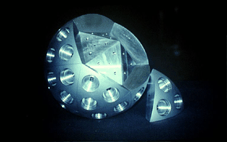
Starlette and Stella
Jump to: Mission Objectives, Mission Instrumentation, Mission Parameters, Additional Information
Mission Photos:

Courtesy of CNES
Mission Objectives:
Starlette (Satellite de Taille Adaptée avec Réflecteurs Laser pour les Etudes de la Terre) and Stella are virtually identical French passive satellites launched by the Centre National d'Etudes Spatiales (CNES) in 1975 and 1993, respectively. Their small size compared to their mass gives them a much larger sensitivity to the gravitational attraction than to the surface forces due either to the residual atmosphere at the satellite or to radiation pressure. Both satellites contain a core made of Uranium-238 (because of its high density near 19 grams/cm3) with 1.5% Molybdenum (for Starlette), and 0.2% Vanadium (for Stella) [R. Biancale, CNES/GRGS, May 2016]. The shell of each body is covered with 20 triangular Aluminum plates, each containing three laser retroreflectors.
Starlette is sensitive to low degree harmonics of the gravity field, more so than the LAGEOS and the Ajisai satellites. Due to its eccentric orbit, Starlette has also been used to study the main coefficients of the oceanic tides, through the perturbations they cause on the satellite orbit.
The decay in semimajor axis due to the effects of atmospheric drag is currently estimated to be -14 m/year for Starlette, and about
-30 m/year for Stella (these are average values, and the decay rates may be larger near the maximum in the 11-year solar cycle, and less near the minimum of the solar cycle).
Stella, Starlette's twin, is mainly used for gravity field recovery.
Both satellites, along with Ajisai, LAGEOS, LAGEOS-2, and LARES contribute to the estimates of the time-variable gravity field of the Earth.
Mission Instrumentation:
Both Stella and Starlette are spherical and covered with 60 identical synthetic fused silica retroreflectors.
Mission Parameters:
| Starlette | Stella | |
| Sponsor: | CNES (France) | CNES (France) |
| Expected Life: | many decades | many decades |
| Primary Applications: | gravity field | gravity field |
| COSPAR ID: | 7501001 | 9306102 |
| SIC Code: | 1134 | 0643 |
| Satellite Catalog (NORAD) Number: | 7646 | 22824 |
| Launch Date: | February 06, 1975 | September 26, 1993 |
| RRA Diameter: | 24 cm | 24 cm |
| RRA Shape: | sphere | sphere |
| RRA Reflectors: | 60 corner cubes | 60 corner cubes |
| Orbit: | eccentric | circular |
| Inclination: | 48.83 degrees | 98.6 degrees |
| Eccentricity: | 0.0206 | 0.001 |
| Perigee: | 812 km | 804 km |
| Apogee: | 1114 km | 812 km |
| Period: | 104 minutes | 101 minutes |
| Weight: | 47.5 kg | 48 kg |
Additional information:
Web sites:
Publications:
- Cheng, M.K., Shum, C.K., Eanes, R.J., Schutz, B.E. and Tapley, B.D., "Observed temporal variations in the Earth's gravity field from 16-years of Starlette orbit analysis", Proc. XX General Assembly of the IUGG, IAG Symp. No. 3, Vienna, Austria, August 1991.
- Cheng, M.K., Shum, C.K., Eanes, R.J., Shutz, B.E. and Tapley, B.D., "Long-Period Perturbations in Starlette Orbit and Tide Solution", J. Geophys. Res., 95, B6, pp. 8723-8736, 1990.
- Dow, J.M., Duque, P., and Merino, M.R., "Global Geodynamics from Lageos and Starlette Combination Solutions", Adv. Space Res., V.11, (6), 119-124, 1991.
- Eanes, R., Schutz, B., and Tapley, B., "Earth and Ocean Tide Effects on Lageos and Starlette", the Proc. of the Ninth International Symp on Earth Tides, pp. 239-250, 1983.
- Gutierrez, R., and Wilson, C.R., "Seasonal Air and Water Mass Redistribution Effects on LAGEOS and Starlette", Geophys. Res. Let., 14, pp. 929-932, 1987.
- Marsh, J.G., Lerch, F.J., and Williamson, R.G., "Precision Geodesy and Geodynamics Using Starlette Laser Ranging", J. Geophys. Res., 90, pp. 9335-9345, 1985.
- Moore, P., "Laser Station Coordinates and Baselines from Long-Arc and Short-Arc Analyses of Starlette", Bull. Geod., V.60, pp. 297-310, 1986.
- Schutz, B.E., Cheng, M.K., Eanes, R.J., Shum, C.K., and Tapley, B.D., "Geodynamic Results from Starlette Orbital Analysis", Contributions of Space Geodesy in Geodynamics, AGU Geodynamics Series, V.24, pp. 175-190, Edited by D.E. Smith and D.L. Turcotte, 1993.
- Schutz, B.E., Cheng, M.K., Shum, C.K., Eanes, R.J., and Tapley, B.D., "Analysis of Earth Rotation Solution from Starlette", J. Geophys. Res.94, pp. 10167-10174, 1989.
- Vermaat, E., "On-Site Integration of Starlette in a Taylored Field", Proc. of the 4th International Workshop on Laser Ranging Instrumentation, Austin, Texas, published by Geodetic Institute, Univ. of Bonn, October 12-16, p. 367, 1981.
- Williamson, R.G., and Marsh, J.G., "STARLETTE Geodynamics: The Earth's Tidal Response", J. Geophys. Res., 90, pp. 9346-9352, 1985.




